Quality Evaluation and Identification of Phyllanthi fructus (Yuganzi) Based on the Spectrum-Effect Relationship
Abstract
:1. Introduction
2. Materials and Methods
2.1. Plant Materials and Reagents
2.2. Apparatus
2.3. Sample Preparation
2.4. Optimization of HPLC Conditions
2.5. Method Validation for HPLC Fingerprint Analysis
2.6. Determination of the HPLC Fingerprint
2.7. Hierarchical Cluster Analysis (HCA)
2.8. Antioxidant Activity
2.9. Establishment of Spectrum-Effect Relationship
3. Results and Discussion
3.1. Optimization of HPLC Chromatographic Conditions
3.2. Method Validation for the HPLC Fingerprint Analysis
3.3. Analysis of HPLC Fingerprints and Similarities
3.3.1. Establishment of the Fingerprint and Characteristic Chromatogram
3.3.2. Similarity Analysis of the HPLC Fingerprints of Yuganzi
3.3.3. Hierarchical Cluster Analysis (HCA)
3.3.4. Antioxidant Activity Test Results
3.3.5. The Results of Spectrum-Effect Relationship Analysis
4. Conclusions
Author Contributions
Funding
Data Availability Statement
Acknowledgments
Conflicts of Interest
References
- Nayak, P.; Behera, P.R.; Thirunavoukkarasu, M.; Chand, P.K. High frequency plant regeneration through adventitious multiple shoot organogenesis in epicotyl explants of Indian gooseberry (Emblica officinalis Gaertn). Sci. Hortic. 2010, 123, 473–478. [Google Scholar] [CrossRef]
- Gantait, S.; Mahanta, M.; Bera, S.; Verma, S.K. Advances in biotechnology of Emblica officinalis Gaertn. syn. Phyllanthus emblica L.: A nutraceuticals-rich fruit tree with multifaceted ethnomedicinal uses. 3 Biotech 2021, 11, 62. [Google Scholar] [CrossRef] [PubMed]
- Saini, R.; Sharma, N.; Oladeji, O.S.; Sourirajan, A.; Dev, K.; Zengin, G.; El-Shazly, M.; Kumar, V. Traditional uses, bioactive composition, pharmacology, and toxicology of Phyllanthus emblica fruits: A comprehensive review. J. Ethnopharmacol. 2022, 282, 114570. [Google Scholar] [CrossRef]
- Yan, X.; Li, Q.; Jing, L.; Wu, S.; Duan, W.; Chen, Y.; Chen, D.; Pan, X. Current advances on the phytochemical composition, pharmacologic effects, toxicology, and product development of Phyllanthi Fructus. Front. Pharmacol. 2022, 13, 191017268. [Google Scholar] [CrossRef]
- Li, W.; Zhang, X.; Chen, R.; Li, Y.; Miao, J.; Liu, G.; Lan, Y.; Chen, Y.; Cao, Y. HPLC fingerprint analysis of Phyllanthus emblica ethanol extract and their antioxidant and anti-inflammatory properties. J. Ethnopharmacol. 2020, 254, 112740. [Google Scholar] [CrossRef] [PubMed]
- Li, G.; Jiang, Y.; Zhang, D.; Han, L.; Mo, T.; Fan, S.; Huang, H.; Lin, J. Phyllanthi Fructus: A modal medicinal and food homologous item in quality evaluation. Chin. Herb. Med. 2023, 15, 360–368. [Google Scholar] [CrossRef]
- Liu, X.; Zhao, M.; Wu, K.; Chai, H.; Yu, H.; Tao, Z.; Wang, J. Immunomodulatory and anticancer activities of phenolics fromemblica fruit (Phyllanthus emblica L.). Food Chem. 2012, 131, 685–690. [Google Scholar] [CrossRef]
- Gan, J.; Zhang, X.; Ma, C.; Sun, L.; Feng, Y.; He, Z.; Zhang, H. Purification of polyphenols from Phyllanthus emblica L. pomace using macroporous resins: Antioxidant activity and potential anti-Alzheimer’s effects. J. Food Sci. 2022, 87, 1244–1256. [Google Scholar] [CrossRef]
- Zhang, Y.J.; Tanaka, T.; Iwamoto, Y.; Yang, C.R.; Kouno, I. Novel norsesquiterpenoids from the roots of Phyllanthus emblica. J. Nat. Prod. 2000, 63, 1507–1510. [Google Scholar] [CrossRef] [PubMed]
- Avula, B.; Wang, Y.H.; Wang, M.; Shen, Y.H.; Khan, I.A. Simultaneous determination and characterization of tannins and triterpene saponins from the fruits of various species of Terminalia and Phyllantus emblica using a uhplc-uv-ms method: Application to triphala. Planta Med. 2013, 29, 181–188. [Google Scholar] [CrossRef]
- Chatterjee, U.R.; Bandyopadhyay, S.S.; Ghosh, D.; Ghosal, P.K.; Ray, B. In vitro anti-oxidant activity, fluorescence quenching study and structural features of carbohydrate polymers from Phyllanthus emblica. Int. J. Biol. Macromol. 2011, 49, 637–642. [Google Scholar] [CrossRef]
- Zhang, Y.J.; Tanaka, T.; Yang, C.R.; Kouno, I. New phenolic constituents from the fruit juice of Phyllanthus emblica. Chem. Pharm. Bull. 2001, 49, 537–540. [Google Scholar] [CrossRef]
- Panchabhai, T.S.; Ambarkhane, S.V.; Joshi, A.S.; Samant, B.D.; Rege, N.N. Protective effect of Tinospora cordifolia, Phyllanthus emblica and their combination against antitubercular drugs induced hepatic damage: An experimental study. Phytother. Res. 2008, 22, 646–650. [Google Scholar] [CrossRef]
- Jaijoy, K.; Soonthornchareonnon, N.; Panthong, A.; Sireeratawong, S. Anti-inflammatory and analgesic activities of the water extract from the fruit of Phyllanthus emblica Linn. Int. J. Appl. Res. Nat. Prod. 2010, 3, 48–58. [Google Scholar]
- Sripanidkulchai, B.; Junlatat, J. Bioactivities of alcohol based extracts of Phyllanthus emblica branches: Antioxidation, antimelanogenesis and anti-inflammation. J. Nat. Med. 2014, 68, 615–622. [Google Scholar] [CrossRef]
- Yang, H.; Yang, T.; Gong, D.; Li, X.; Sun, G.; Guo, P. A trinity fingerprint evaluation system of traditional Chinese medicine. J. Chromatogr. A 2022, 1673, 463118. [Google Scholar] [CrossRef]
- Zhang, H.; Wei, Z.; Tong, Y.; Song, X.; Li, S.; Sun, Y.; Liu, C.; Han, F.; Yu, J. Spectrum-effect relationship study to reveal the pharmacodynamic substances in Flos Puerariae-Semen Hoveniae medicine pair for the treatment of alcohol-induced liver damage. J. Ethnopharmacol. 2023, 314, 116628. [Google Scholar] [CrossRef]
- Yang, H.; Li, Q. Optimization of extraction process and the antioxidant activity spectrum-effect relationship of Angelica dahurica. Biomed. Chromatogr. 2022, 36, e5322. [Google Scholar] [CrossRef]
- Gao, S.; Chen, H.; Zhou, X. Study on the spectrum-effect relationship of the xanthine oxidase inhibitory activity of Ligustrum lucidum. J. Sep. Sci. 2019, 42, 3281–3292. [Google Scholar] [CrossRef] [PubMed]
- Liu, X.; Yang, J.; Yang, Y.; Yang, Y.; Kang, X.; Ye, Y.; Li, X.; Wu, Y.; Xiao, J.; Li, L.; et al. Research on the hemostasis and coagulation effects of Callicarpa nudiflora based on the spectrum-effect relationship. Nat. Prod. Res. 2023, 30, 1–8. [Google Scholar] [CrossRef] [PubMed]
- Zhu, L.; Fang, L.; Li, Z.; Xie, X.; Zhang, L. A HPLC fingerprint study on Chaenomelis Fructus. BMC Chem. 2019, 13, 7. [Google Scholar] [CrossRef]
- Hawrył, A.; Hawrył, M.; Hajnos-Stolarz, A.; Abramek, J.; Bogucka-Kocka, A.; Komsta, Ł. HPLC Fingerprint Analysis with the Antioxidant and Cytotoxic Activities of Selected Lichens Combined with the Chemometric Calculations. Molecules 2020, 25, 4301. [Google Scholar] [CrossRef]
- Yang, G.; Li, S.; Sun, X.; Lv, Y.; Huang, H. Quality monitoring of Shenmai injection by HPLC pharmacodynamic fingerprinting. BMC Chem. 2023, 17, 28. [Google Scholar] [CrossRef]
- Xue, Y.; Zhu, L.; Yi, T. Fingerprint analysis of Resina Draconis by ultra-performance liquid chromatography. Chem. Cent. J. 2017, 11, 67. [Google Scholar] [CrossRef]
- Han, J.; Xu, K.; Yan, Q.; Sui, W.; Zhang, H.; Wang, S.; Zhang, Z.; Wei, Z.; Han, F. Qualitative and quantitative evaluation of Flos Puerariae by using chemical fingerprint in combination with chemometrics method. J. Pharm. Anal. 2022, 12, 489–499. [Google Scholar] [CrossRef]
- Wang, S.; Zhang, J.; Liu, J.; Qian, G.; Fu, C. Quality evaluation of Huaijiao pill by chromatographic fingerprint and simultaneous determination of its major bioactive components. J. Pharm. Anal. 2016, 6, 249–255. [Google Scholar] [CrossRef]
- Wei, G.; Jia, R.; Kong, Z.; Ji, C.; Wang, Z. Cold-hot nature identification of Chinese herbal medicines based on the similarity of HPLC fingerprints. Front. Chem. 2022, 10, 1002062. [Google Scholar] [CrossRef]
- Schulze, A.E.; De Beer, D.; Mazibuko, S.E.; Muller, C.J.; Roux, C.; Willenburg, E.L.; Nyunaï, N.; Louw, J.; Manley, M.; Joubert, E. Assessing similarity analysis of chromatographic fingerprints of Cyclopia subternata extracts as potential screening tool for in vitro glucose utilisation. Anal. Bioanal. Chem. 2016, 408, 639–649. [Google Scholar] [CrossRef]
- Anwar, S.; Crouch, R.A.; Awadh Ali, N.A.; Al-Fatimi, M.A.; Setzer, W.N.; Wessjohann, L. Hierarchical cluster analysis and chemical characterisation of Myrtus communis L. essential oil from Yemen region and its antimicrobial, antioxidant and anti-colorectal adenocarcinoma properties. Nat. Prod. Res. 2017, 31, 2158–2163. [Google Scholar] [CrossRef] [PubMed]
- Dżugan, M.; Tomczyk, M.; Sowa, P.; Grabek-Lejko, D. Antioxidant Activity as Biomarker of Honey Variety. Molecules 2018, 23, 2069. [Google Scholar] [CrossRef] [PubMed]
- Aline, D.C.S.A.; Rubiana, M.M.; Najeh, M.K. Nanoencapsulation of gallic acid and evaluation of its cytotoxicity and antioxidant activity. Mater. Sci. Eng. C Mater. Biol. Appl. 2016, 60, 126–134. [Google Scholar]
- Choubey, S.; Goyal, S.; Varughese, L.R.; Kumar, V.; Sharma, A.K.; Beniwal, V. Probing Gallic Acid for Its Broad Spectrum Applications. Mini Rev. Med. Chem. 2018, 18, 1283–1293. [Google Scholar] [CrossRef] [PubMed]
- Abdelwahed, A.; Bouhlel, I.; Skandrani, I.; Valenti, K.; Kadri, M.; Guiraud, P.; Steiman, R.; Mariotte, A.M.; Ghedira, K.; Laporte, F.; et al. Study of antimutagenic and antioxidant activities of gallic acid and 1,2,3,4,6-pentagalloylglucose from Pistacia lentiscus—Confirmation by microarray expression profiling. Chem. Biol. Interact. 2007, 165, 1–13. [Google Scholar] [CrossRef] [PubMed]
- Yen, G.C.; Duh, P.D.; Tsai, H.L. Antioxidant and pro-oxidant properties of ascorbic acid and gallic acid. Food Chem. 2002, 79, 307–313. [Google Scholar] [CrossRef]
- Pal, C.; Bindu, S.; Dey, S.; Alam, A.; Goyal, M.; Iqbal, M.S.; Maity, P.; Adhikari, S.S.; Bandyopadhyay, U. Gallic acid prevents nonsteroidal anti-inflammatory drug induced gastropathy in rat by blocking oxidative stress and apoptosis. Free Radic. Bio. Med. 2010, 249, 258–267. [Google Scholar] [CrossRef] [PubMed]
- National Pharmacopoeia Committee. Pharmacopoeia of Peoples Republic of China. Part 2; Chemical Industry Press: Beijing, China, 2020. [Google Scholar]
- Nijat, D.; Lu, C.F.; Lu, J.J. Spectrum-Effect Relationship between UPLC Fingerprints and Antidiabetic and Antioxidant Activities of Rosa rugosa. J. Chromatogr. B 2021, 1179, 122843. [Google Scholar] [CrossRef] [PubMed]
- Wang, F.; Xiong, Z.Y.; Li, P.; Yang, H.; Gao, W.; Li, H.J. From chemical consistency to effective consistency in precise quality discrimination of Sophora flower-bud and Sophora flower: Discovering efficacy-associated markers by fingerprint-activity relationship modeling. J. Pharm. Biomed. Anal. 2017, 132, 7–16. [Google Scholar] [CrossRef] [PubMed]
- Alaerts, G.; Dejaegher, B.; Smeyers-Verbeke, J.; Vander, H.Y. Recent Developments in Chromatographic Fingerprints from Herbal Products: Set-Up and Data Analysis. Comb. Chem. High Throughput Screen. 2010, 13, 900–922. [Google Scholar] [CrossRef]
- Xu, G.L.; Xie, M.; Yang, X.Y.; Song, Y.; Yan, C.; Yang, Y.; Zhang, X.; Liu, Z.Z.; Tian, Y.X.; Wang, Y.; et al. Spectrum-Effect Relationships as a Systematic Approach to Traditional Chinese Medicine Research: Current Status and Future Perspectives. Molecules 2014, 19, 17897–17925. [Google Scholar] [CrossRef]
- Wu, X.; Zhang, H.; Fan, S.; Zhang, Y.; Yang, Z.; Fan, S.; Zhuang, P.; Zhang, Y. Quality markers based on biological activity: A new strategy for the quality control of traditional Chinese medicine. Phytomedicine 2018, 44, 103–108. [Google Scholar] [CrossRef]
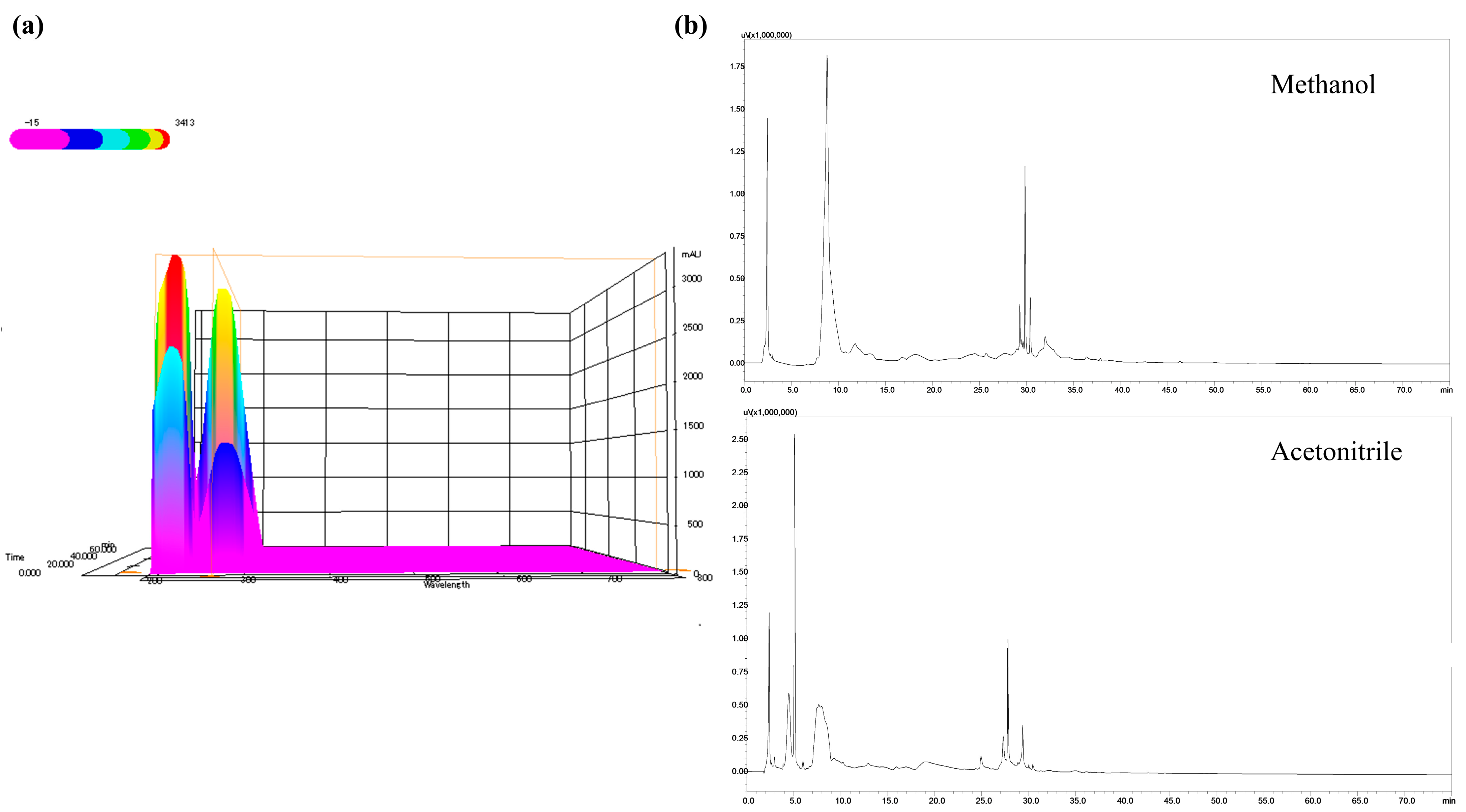
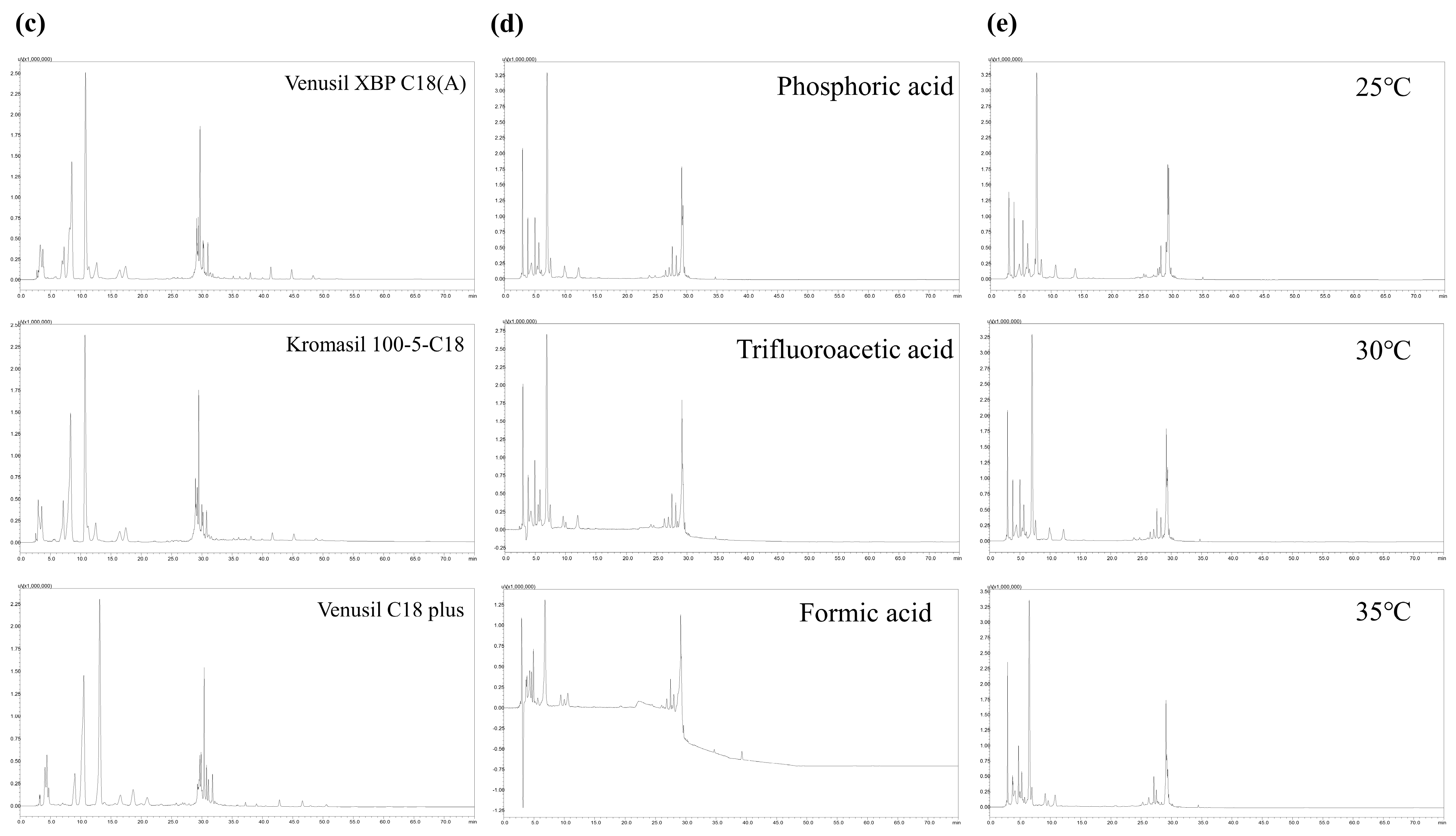

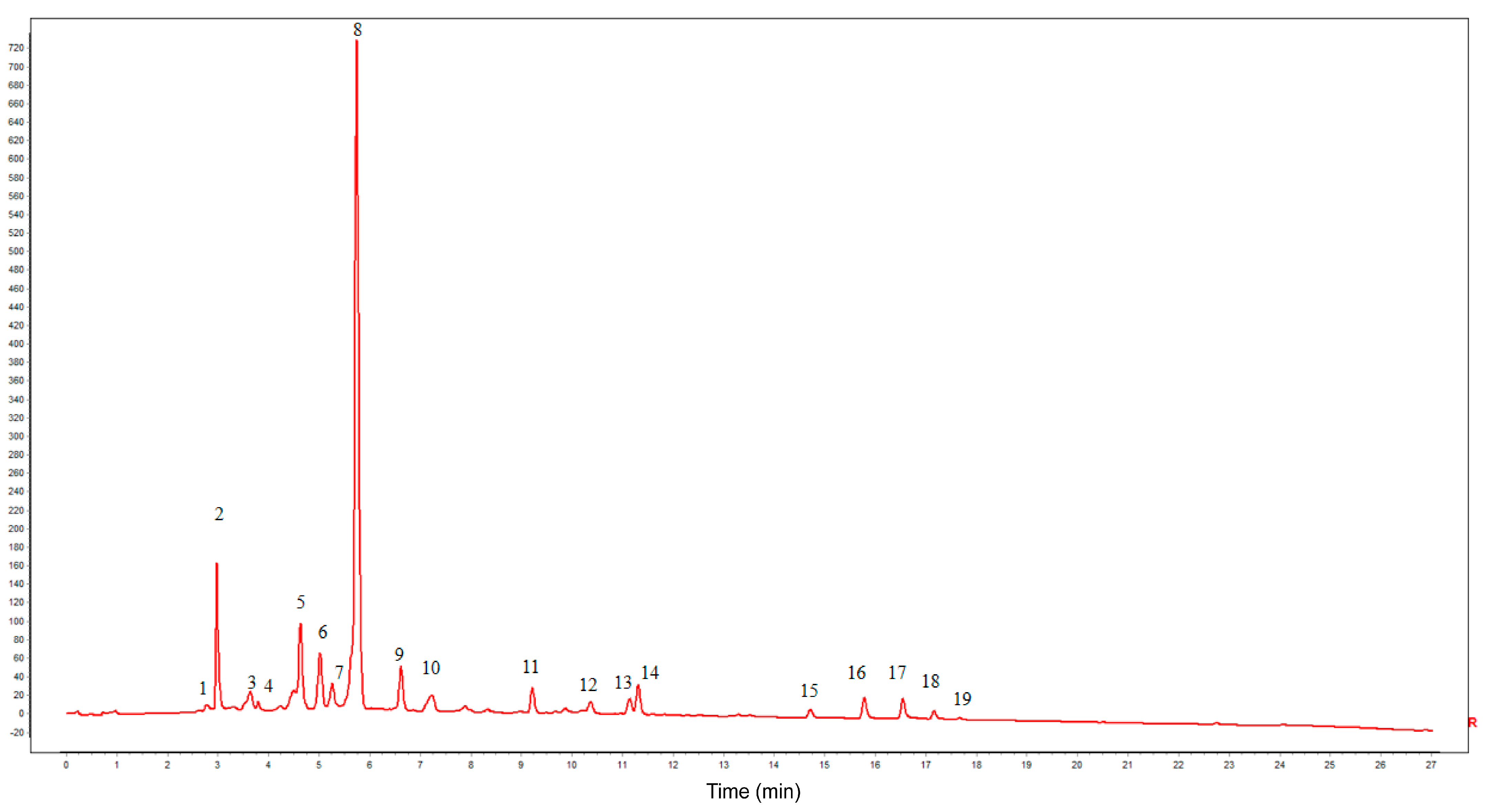
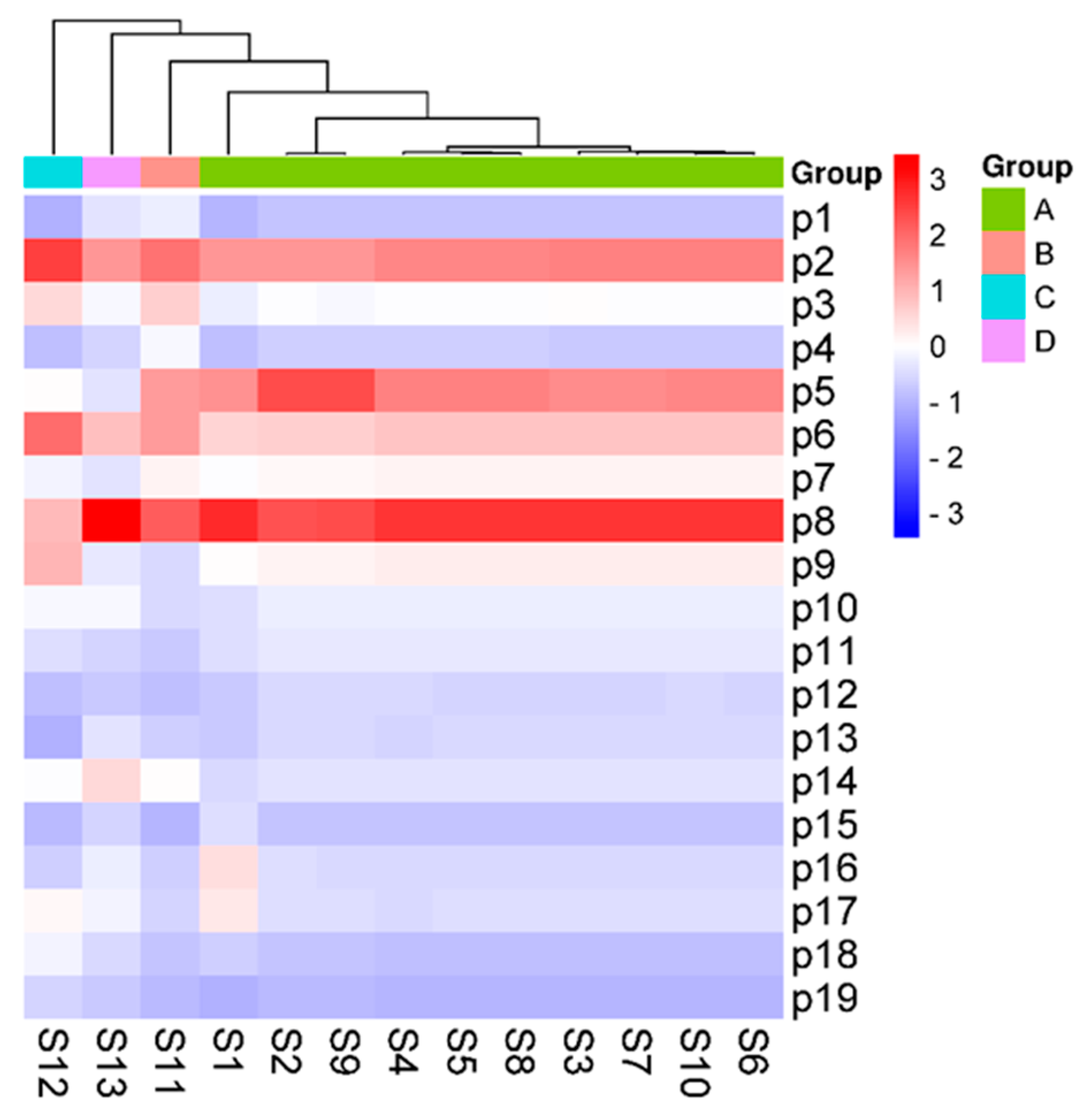

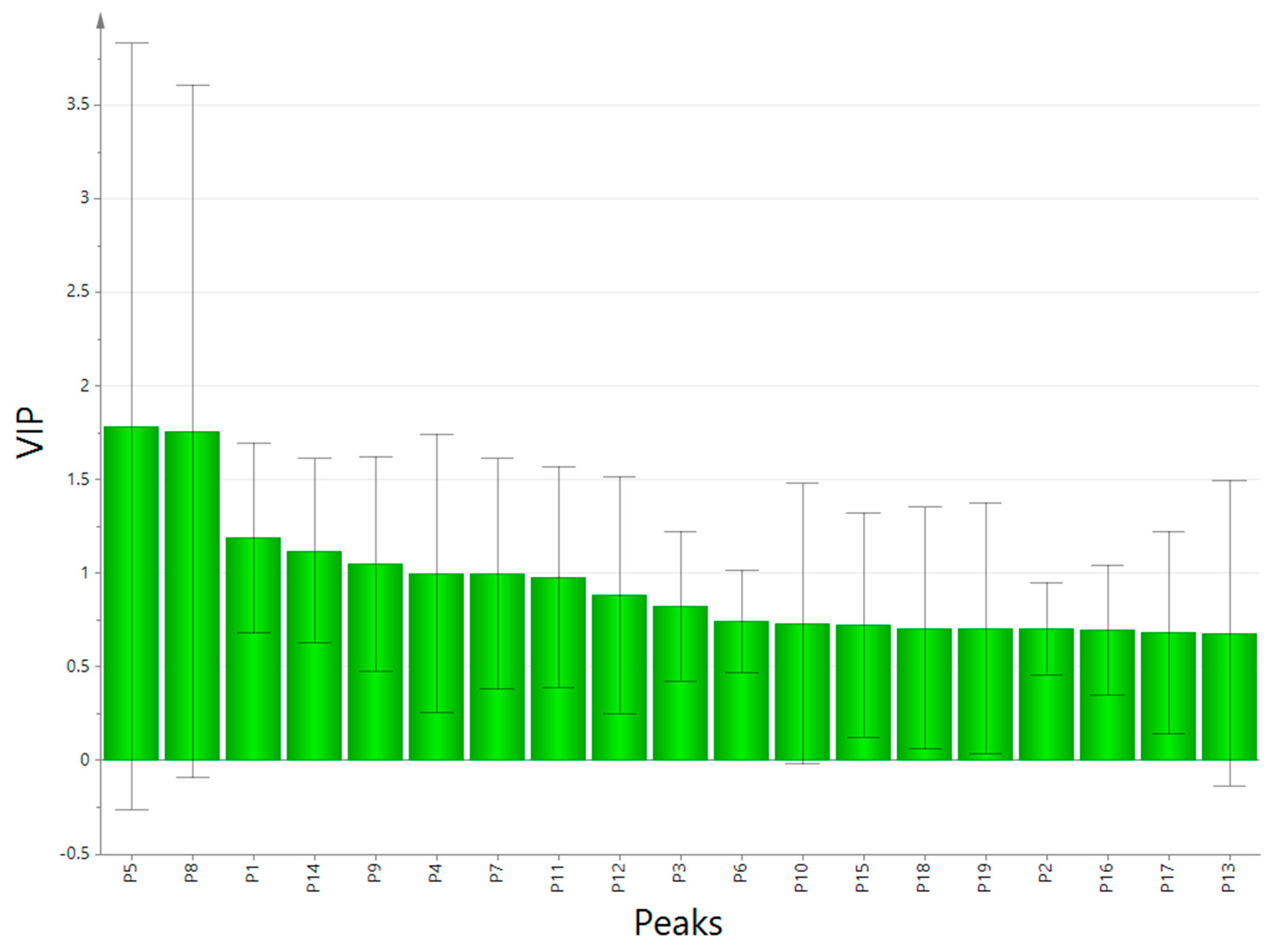
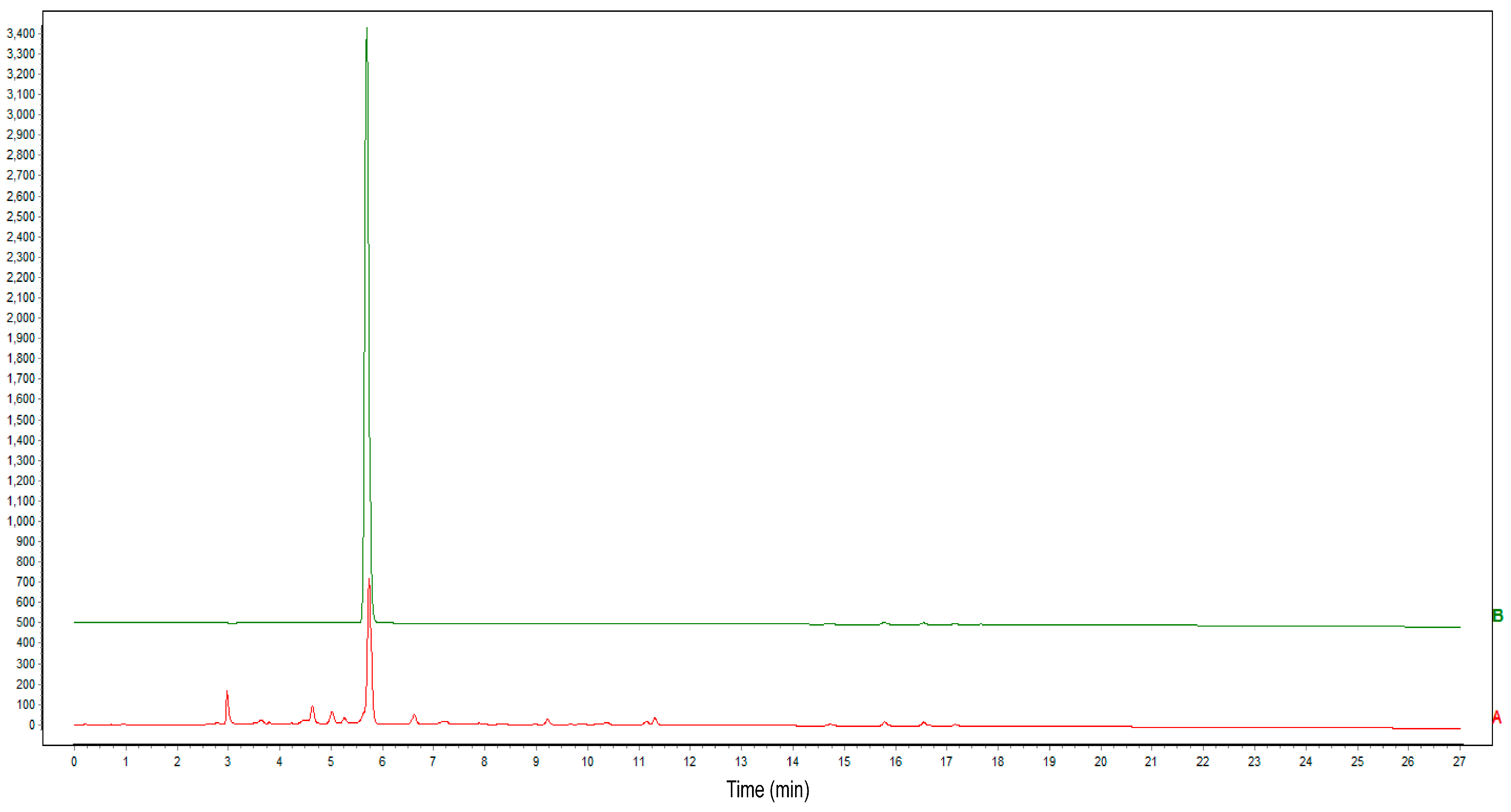
| t/min | Organic Phase (%) | 0.1% Aqueous Phase (%) |
|---|---|---|
| 0.01 | 7 | 93 |
| 6 | 14 | 86 |
| 30 | 30 | 70 |
| 35 | 70 | 30 |
| 40 | 70 | 30 |
| 40.01 | 7 | 93 |
| Separation Conditions | Peak No. | Retention Time | Peak Area |
|---|---|---|---|
| Venusil XBP C18(A) (4.6 × 250 mm, 5 µm) | 94 | 10.796 | 38,794,698 |
| Kromasil 100-5-C18 (4.6 × 250 mm, 5 µm) | 79 | 10.709 | 39,285,826 |
| Venusil C18 plus (4.6 × 250 mm, 5 µm) | 92 | 13.130 | 43,000,712 |
| Water (A), methanol (B) | 51 | 8.0782 | 90,466,269 |
| Water (A), acetonitrile (B) | 60 | 5.085 | 23,792,670 |
| 0.1% phosphoric acid solution (A), acetonitrile (B) | 92 | 7.014 | 46,425,891 |
| 0.1% trifluoroacetic acid solution (A), acetonitrile (B) | 154 | 6.903 | 51,262,774 |
| 0.1% formic acid solution (A), acetonitrile (B) | 158 | 6.821 | 120,584,524 |
| 25 °C | 94 | 7.600 | 42,940,841 |
| 30 °C | 92 | 7.014 | 46,425,891 |
| 35 °C | 93 | 6.524 | 42,825,871 |
| Samples | Similarity Values | Antioxidant Capacity (mmol/mg) |
|---|---|---|
| 1 | 1.000 | 0.296 ± 0.004 |
| 2 | 0.995 | 0.291 ± 0.004 |
| 3 | 0.997 | 0.297 ± 0.002 |
| 4 | 0.997 | 0.291 ± 0.001 |
| 5 | 0.997 | 0.292 ± 0.001 |
| 6 | 0.997 | 0.291 ± 0.003 |
| 7 | 0.997 | 0.290 ± 0.002 |
| 8 | 0.997 | 0.292 ± 0.004 |
| 9 | 0.995 | 0.295 ± 0.002 |
| 10 | 0.997 | 0.292 ± 0.005 |
| 11 | 0.986 | 0.311 ± 0.001 |
| 12 | 0.841 | 0.338 ± 0.001 |
| 13 | 0.973 | 0.316 ± 0.001 |
Disclaimer/Publisher’s Note: The statements, opinions and data contained in all publications are solely those of the individual author(s) and contributor(s) and not of MDPI and/or the editor(s). MDPI and/or the editor(s) disclaim responsibility for any injury to people or property resulting from any ideas, methods, instructions or products referred to in the content. |
© 2024 by the authors. Licensee MDPI, Basel, Switzerland. This article is an open access article distributed under the terms and conditions of the Creative Commons Attribution (CC BY) license (https://creativecommons.org/licenses/by/4.0/).
Share and Cite
Zhou, W.; Wu, B.; Liu, L.; Li, J.; Shi, D.; Li, X. Quality Evaluation and Identification of Phyllanthi fructus (Yuganzi) Based on the Spectrum-Effect Relationship. Separations 2024, 11, 104. https://doi.org/10.3390/separations11040104
Zhou W, Wu B, Liu L, Li J, Shi D, Li X. Quality Evaluation and Identification of Phyllanthi fructus (Yuganzi) Based on the Spectrum-Effect Relationship. Separations. 2024; 11(4):104. https://doi.org/10.3390/separations11040104
Chicago/Turabian StyleZhou, Weiwei, Bencheng Wu, Ling Liu, Jun Li, Dongdong Shi, and Xiumei Li. 2024. "Quality Evaluation and Identification of Phyllanthi fructus (Yuganzi) Based on the Spectrum-Effect Relationship" Separations 11, no. 4: 104. https://doi.org/10.3390/separations11040104





